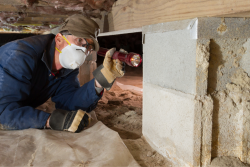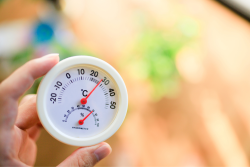A blow-in or loose-fill insulation system consists of filling stud or joist cavities with materials with a high R-value and can insulate effectively. In blown-in insulation, a long hose is used to blow tiny pieces of material into walls, attics, joists and cavities. For blow-in applications, the most common material is cellulose. However, styrofoam pellets and loose fibreglass fibres can also be used. Read the full article to learn more about blown-in insulation.
Added to Existing Walls Without Hassle
You can insulate existing exterior walls with blown-in insulation from inside or outside the home. This type of insulation offers the advantage of sealing small gaps and spaces as it settles, preventing cold air from entering these sneaky spots in the walls of your house. When you insulate from the outside, some siding panels must be removed for large holes to be bored through the sheathing above the wall studs. The process of blowing insulation into walls from inside the home involves the same steps; however, instead of removing siding, large holes are cut through the drywall.
Types of Blown-in Insulation
Cellulose, loose-fill fibreglass, and rock wool are the three most common types of blown-in insulation. Each material offers unique benefits and disadvantages. Ask your local insulation company which would be most appropriate for your area based on the minimum recommended insulation values for each. To decide which is perfect for your needs, contact a professional insulation contractor Reitzel Insulation.
It is Readily Available
Most lumberyards and home improvement stores sell bags of cellulose insulation and loose-fill fibreglass insulation. Rock wool insulation is a specialty product that can be purchased on order. You will also need a blower if you add the insulation yourself. Some stores will loan you a blower for free if you buy ten or more bags of insulation.
Blown-in Insulation Lasts a Long Time
This insulating material will retain most thermal resistance for decades under ideal circumstances, such as expert installation, minor settling, and little to no water damage. Typically, fibreglass insulation lasts for about 80 to 100 years, but it should be checked for signs of damage after 15 years. Cellulose insulation has an average lifespan of 20 to 30 years due to its recycled composition and low moisture resistance. Rock wool is the material with the most longevity as it is moisture-resistant.
You can DIY it But Hiring A Professional is Recommended
Professionals should blow insulation into walls because it involves drilling into studs that may contain electrical wiring and pipes. In contrast, blowing insulation into an attic can be done by anybody. Although it doesn't require special abilities, you must crouch and crawl under low and sloping attic rafters to disperse the insulation uniformly. To finish an attic insulation project effectively, adhere to the directions printed on each insulation bag and the blower or hire a professional and save the hassle.
Disadvantages of Blown-in Insulation
Holes are drilled to blow insulation material into existing walls. Plugs that match the siding are then used to seal these holes. If the siding is brick or stucco, the plugs are often visible even though they are closely matched to the siding's colour. Furthermore, blown-in insulation has the disadvantage of not covering the entire stud space due to obstructions in the wall space, such as drainpipes or outlet boxes.
Also, see Top Tips to Winterize Your Home in 2023.
Make your home more energy-efficient and better using our professional insulation services. Reitzel Insulation has a team of experts who can guide you about different insulation materials and methods. For any queries, feel free to contact us.

















